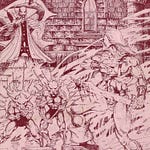White Dwarf Issue #4, published Dec/Jan 1978, released when the British gaming scene was still struggling to figure out just what it wanted to be. Livingstone’s editorial adopts a polemical tone, lamenting the dominance of American-made games like D&D, you might be finding a common theme here, while championing British ingenuity. He critiques the lack of domestic innovation in board wargames and fantasy miniatures, framing the issue as a call to arms for UK designers to reclaim commercial and cultural relevance. This editorial stance underscores the broader tensions of the era, where the burgeoning popularity of RPGs collided with concerns about creative sovereignty. This theme would later define Games Workshop's rise as a counterweight to the Transatlantic giants.
The issue’s centrepiece, Don Turnbull's Alice in Dungeonland, exemplifies the era’s experimental approach to game design. A whimsical yet mechanically rigorous adaptation of Lewis Carroll’s Through the Looking Glass, the adventure transposes Wonderland’s absurdist logic into a dungeon-crawling framework. Turnbull reimagines Carroll’s iconic scenes, the Red Queen’s chessboard, Humpty Dumpty’s cryptic dialogue as tactical challenges, blending narrative whimsy with Gygaxian crunch. The “travelator” corridor, which forces players to outrun a moving floor, and the chess problem finale, which demands lateral thinking, highlight the period’s fascination with puzzles as gameplay. While the scenario risks tonal dissonance (Carroll’s gentle satire clashes with D&D’s combat focus), it remains a fascinating artefact of early attempts to bridge literary inspiration and procedural generation.
Lewis Pulsipher’s D&D Campaigns: Part II: Mechanics offers a counterpoint to Turnbull's whimsy, advocating for systematic rigour in dungeon mastering. His advice of using hexagonal grids for wilderness exploration, pre-rolling wandering monsters, and tracking time via segmented charts reveals a push toward standardisation in a hobby still defined by ad hoc rulings. Notably, Pulsipher critiques the unrealistic density of dungeon ecosystems, urging DMs to consider logistics like food sources and territorial disputes among monsters. This emphasis on verisimilitude anticipates later movements toward “simulationist” play, though his suggestion to balance encounters based on party experience points feels somewhat quaint against modern design paradigms.
Tony Bath’s Hyboria article, a deep dive into adapting Robert E. Howard’s Conan mythos for wargaming, exemplifies the era’s maximalist worldbuilding. Bath’s approach is exhaustively taxonomic: he grids a map of Howard’s fictional continent, assigns military colour codes to factions, and devises a card-based system for generating noble family lineages. While ostensibly a guide to creating a Conan-themed campaign, the piece doubles as a manifesto for immersive storytelling, treating geopolitical detail as a prerequisite for emergent narrative. Bath’s methodology, part historian, part game designer, foreshadows the worldbuilding rigour of later RPG settings like Glorantha or Forgotten Realms, albeit with a distinctly pre-digital, analogue sensibility.
In Monsters Mild and Malign, Don Turnbull returns with a bestiary showcasing the era’s fascination with mechanically novel creatures. Eschewing mere stat block inflation, Turnbull designs monsters as narrative devices: the Glitch disrupts magic in melee, the Typo warps spell effects via linguistic chaos, and the Black Leech escalates damage through persistent attachment. These creations reflect a shift from combat as war to combat as a puzzle, demanding player creativity over brute force. However, the article’s lack of playtesting transparency and balance metrics beyond the previously discussed “Monstermark” scores highlights the period’s trial-and-error design culture, where imbalance was often a feature, not a bug.
Fred Hemmings's Competitive D&D closes the issue with a pragmatic guide to structuring tournament-style play. His fifth-level dungeon, featuring timed objectives and a points system, prioritises strategic resource management over narrative immersion. Rooms like The Tomb of Akhnaten, a multi-layered trap requiring the Ankh artefact to bypass cursed chests, emphasise meta-game problem-solving. At the same time, the Horsemen of the Apocalypse encounter underscores a high-stakes risk/reward calculus. Hemmings' advice on pre-generated characters and objective-based scoring reveals the tension between D&D's open-ended roots and the competitive scene’s demand for fairness, a tension still debated in modern RPG discourse.
Retrospectively, White Dwarf Issue #4 beautifully blends the whimsy of Alice in Wonderland with the statistical rigour of D&D, and ambition mirrors the broader shift from wargaming’s niche pastime to RPGs’ cultural ascendance. Yet the issue’s nationalistic undertones, Livingstone’s editorial, Bath’s Eurocentric worldbuilding, also reflect the hobby’s insularity, a myopia that would gradually dissolve as the global RPG community coalesced. Particularly with the advent of the internet some two decades later. As a blueprint, the magazine remains essential for understanding the genre’s formative years, a chaotic alchemy of literary homage, systemic innovation, and unapologetic geekery.












Share this post